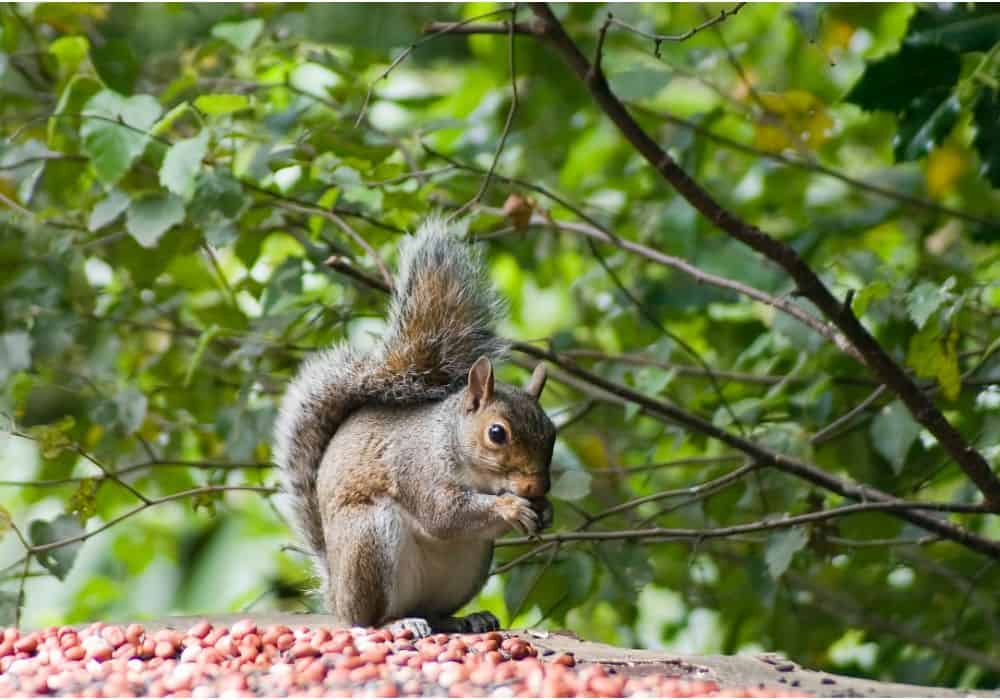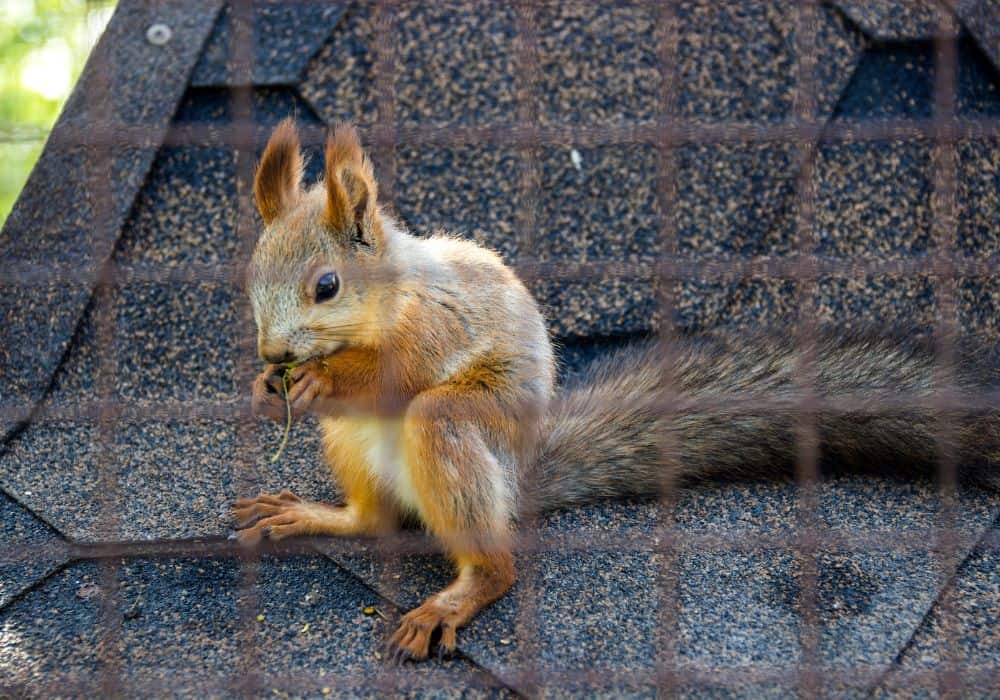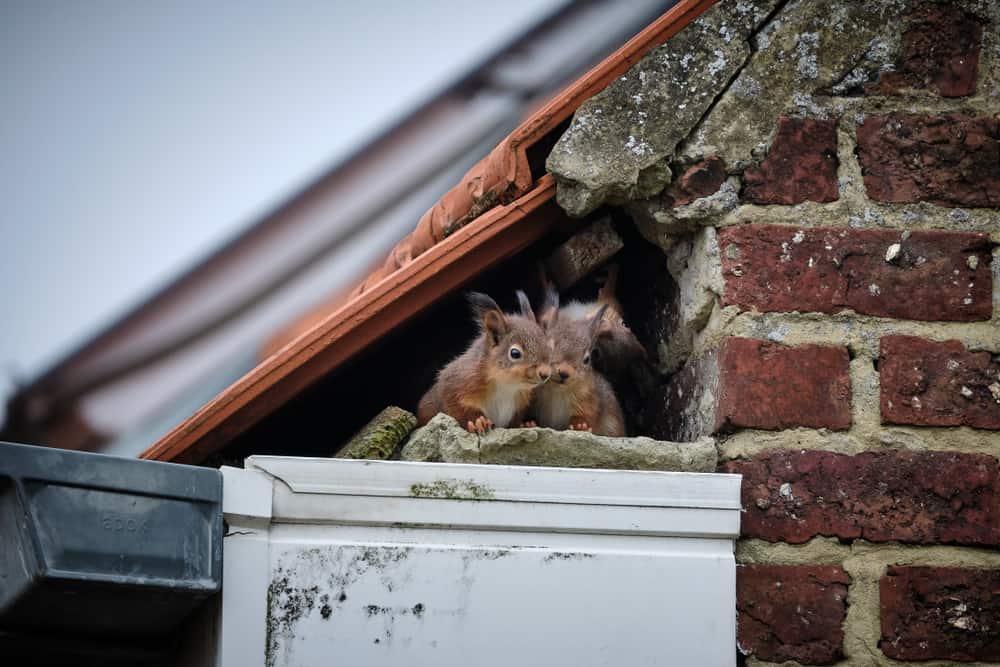Squirrels aren’t seen as “pests” as commonly as rats or mice, however, they can absolutely become pests if they decide to settle inside your home’s walls. And, indeed, people who live in suburban or rural areas near treelines can often attest that squirrels can do much more structural damage to your home much faster than many other notorious pests such as rats, termites, or carpenter ants.
So, whether you’re just now stumbling upon this problem or you want to prevent it from ever happening to you – here are our 7 key steps and other tips for how to get squirrels out of the walls of the house and how to keep them out in the first place.
Why Even Are There Squirrels in Your Home’s Walls?
For the urban-dwellers, the entire prospect of squirrels living in people’s walls can sound nonsensical. It’s very much a thing, however. In fact, squirrels are among the most common non-insect house pests in certain areas, alongside mice, raccoons, and bats.
The reason for that is simple – squirrels love nesting in tight, secluded, and warm wooden spaces where they can stay safe from predators and from nature’s elements. Especially during the mating seasons – typically December-February and June-August – when squirrels are looking for secure hollows for their newborns, they are likely to settle into people’s homes’ walls.
A house’s walks offer everything a squirrel needs outside of food sources – security, confined spaces, and lots of things to chew on. This last part can sound silly but it’s crucial and it’s the key reason why squirrels can be so dangerous for your home.
These tiny mammals are famous for their large and sharp incisor teeth but there is a catch – those incisor teeth grow all the time. The evolutionary reason for that is so that they can grow their incisors back if something happens to them – a squirrel very much relies on its incisor teeth for its survival. The drawback, however, is that squirrels need to chew on things all the time, not just when they are eating, as that helps them keep their growing incisors in check.
If a squirrel doesn’t have the right stuff to chew on, its incisors can grow so long that they start jamming into the animal’s lower jaw. What this means for homeowners is that, even though the inside of our walls and attics don’t offer any food sources for squirrels, they offer plenty of things to chew on. This is exactly what makes them so destructive – yes, they spend a lot of time every day outside, looking for food and not bothering us, but when they get back in their hollows inside our walls, they keep chewing on the cables and wood that are there.
How to Get Rid of Squirrels out of the Walls of the House?

So, let’s go over a quick step-by-step guide so that you know what to do and which steps not to skip.
Step 1: Make sure you really are dealing with squirrels
Squirrels are definitely not the only animal that can start nesting inside your attic and walls seemingly out of nowhere. Knowing what you’re dealing with ahead of time is crucial so that you know what measures to take.
The different types of in-wall animal pests are usually easiest to recognize by looking at these two factors:
- What type of noise they are making?
- When are they the loudest and most active?
If you want a video explainer of how this works, here’s a good and quick video on the topic by All Wildlife Removal Inc.
Otherwise, here are a few main pointers:
- Squirrels tend to be faster and noisier than other similar pests. Raccoons are slow and heavy while mice know not to make noise when you start snooping around their homes (i.e. your walls).
- Most other pets are nocturnal but squirrels are active during the day and sleep when we sleep. So, if you hear noises in the middle of the night – it’s not squirrels.
- While they are active during the day, squirrels also go outside to look for food in the woods. So, you really won’t be hearing much from them in the middle of the day either. Instead, you’re most likely to hear squirrels in the morning and in the evening – when they are going out and coming back.
As a secondary point, it’s also important to make sure that you know how many squirrels you’re dealing with. These animals are usually solitary but during their mating seasons, they can nest in larger groups consisting of a couple adults and multiple babies.
Step 2: Locate all entry and exit points
It’s important to be aware of all actively used and potential entry and exit points. Missing even one will make your further efforts partly or mostly meaningless as the squirrels will still have a hole to go in and out of.
Step 3: Seal all but one of the exit points
Leave one hole unsealed as that’s the hole you’ll set your trap in front of. All other holes should be sealed so the squirrels are forced to go out of where you want them to. You can use caulk or steel wool, or pet one-way doors. Remember to set up chimney caps too as squirrel nests can use the chimney as an entry point.
Step 4: Set the right squirrel trap with the right bait
A good and large metal live trap with a bait of peanut butter or some other nuts should be perfect for any squirrel. Make sure the trap is sturdy and secure enough as squirrels can be surprisingly strong and nifty sometimes. Pet foods can work too as do other food sources.
Step 5: Trim the closest trees to your home
This is partly a preventative measure but it’s also important while you’re actively trying to rid yourself of squirrels. Trimming all nearby trees makes sure that the squirrels (either the ones running away or the ones that might come later) don’t have any incentive to stick around your home. Remove any bird feeders from your yard too for the same reason. Setting up a bright light source for the night can also work as a squirrel repellent.
Step 6: Once (you think) you’re done, seal the remaining holes but with a temporary sealant
This step is important – make sure that you first use a temporary sealant such as a pet door or something else. This is done as you may have to redo the previous 5 steps if you’ve missed a few squirrels.
Step 7: Wait a few days to make sure the problem is gone and then seal all possible entry points properly and permanently
Be on the lookout for the smell of feces or squirrel urine. Also, look for structural water damage from said urine. If you sense something like that you may have to open up the temporarily sealed entry points and either get rid of the rest of the squirrels and/or clean their former living space. Then and only then should you seal all entry points permanently so that no future infestations can be established.
How about Poison and Kill Traps?

We’d generally advise against using poison and/or kill traps for squirrels. There are numerous reasons for that:
- First, there are the moral justifications – squirrels are intelligent and emotional animals that don’t do what they do out of malice and don’t act as pests when they are released back in the woods.
- Second, many counties and states in the US have restrictions on the residential use of rodenticide products.
- Next, poisons and kill traps are just nasty to deal with – a live trap is much easier and cleaner.
- Lastly, poison and kill traps pose a danger for kids, pets, and non-pest animals.
So, we’d typically recommend to steer clear of such products and tools.
When should you Call a Professional?
Our immediate instinct is to recommend calling professional squirrel removal as soon as you notice the problem. This just tends to be the safest option in most cases – otherwise, it’s very common for homeowners to end up spending way too much time and resources than what’s necessary, miss a few entry/exit points, miss a few squirrels still hiding inside their walls before sealing them, and so on.
Hiring a professional tends to be the simplest and easiest way to avoid any such risks and pitfalls, however, that obviously costs a fair amount too, especially in some parts of the US. So, if you’re confident that you can deal with the problem yourself and you’ve done the necessary research and preparation, there’s nothing wrong with first taking a crack at the issue yourself.
If you know or suspect that there are numerous squirrels in your walls, especially babies (which likely won’t be caught in the traps if they are too young to go out), it is a good idea to contact a professional right away. The last thing you want is a bunch of baby squirrels dying inside your walls – not only is that morally horrific but it tends to smell a lot too.
In Conclusion
All in all, squirrels can be quite problematic for homeowners but they are not an unmanageable problem. The one most important factor in how much damage they are going to do to your house and how easy can you deal with the issue is when exactly you manage to catch the problem.
If you notice the unwanted presence inside your walls soon enough and take the appropriate measures, you’ll likely get away with very minimal repairs and expenses. However, if you don’t spot the problem soon enough and/or you don’t act fast enough, you may need to do quite a lot of repair work. In some cases, a squirrel infestation can be an outright safety risk as they can chew through some important electrical cables or outright undermine the structural integrity of the ceiling and roof over your head.
